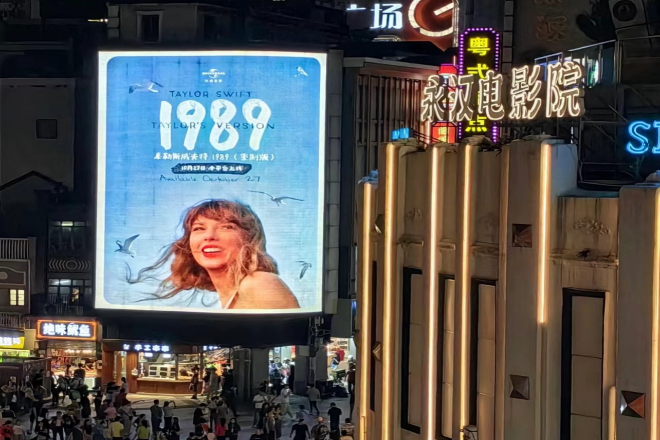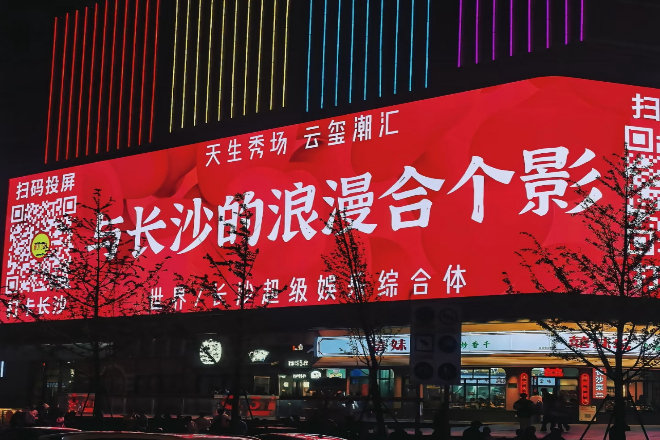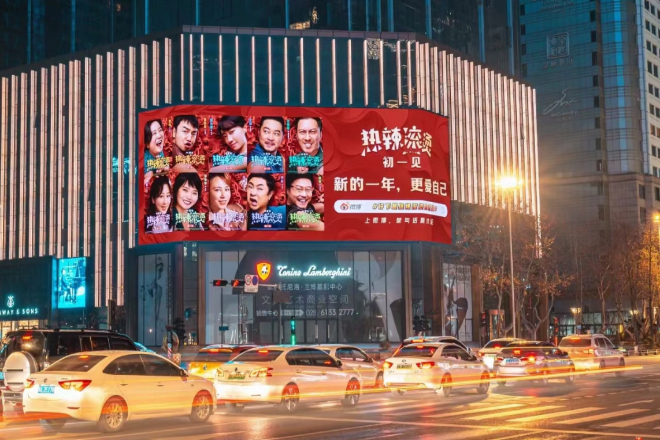مقدمة
With the acceleration of urbanization and the prosperity of the nighttime economy, شاشات عرض LED خارجية, as an important carrier for information transmission and advertising display, play an increasingly important role at night.
However, the light conditions in the nighttime environment are complex and changeable. How to ensure that outdoor LED display screens can efficiently and clearly display content at night has become a problem to be solved.
1. What are the actual benefits of outdoor LED display screens achieving efficient visibility at night?
The actual benefits of outdoor LED display screens achieving efficient visibility at night are mainly reflected in the following aspects:
1). Enhance advertising effect and information dissemination ability
- Enhance visual impact:
Outdoor LED display screens have high brightness and high contrast and can clearly display images and video content even at night.
This high-سطوع display effect can attract the attention of pedestrians, enhance the visual impact of advertisements or information, and improve the efficiency of information transmission.
- All-weather broadcast:
Outdoor LED display screens are not restricted by time and can broadcast advertisements and information around the clock.
At night, its efficient visibility ensures the continuous dissemination of information and extends the effective exposure time of advertisements.
2). Beautify the city night view and enhance the city image
- Become a beautiful landscape of the city:
Outdoor LED display screens add a touch of bright color to the city at night with their bright colors and vivid pictures. They not only convey information but also become an important part of the city’s night view, enhancing the overall image and beauty of the city.
- Adapt to various scenes:
Whether in commercial blocks, transportation hubs, or public places, outdoor LED display screens can perfectly blend with the surrounding environment, adding a unique charm to the city night view.
3). Improve safety and convenience
- Real-time update of traffic information:
In the field of transportation, outdoor LED display screens can update road conditions, traffic guidance, etc., in real-time to improve road safety and traffic efficiency.
Efficient visibility at night ensures that drivers and pedestrians can clearly see the information on the screen and respond in time.
- Emergency information release:
In an emergency, outdoor LED display screens can quickly release emergency information, such as weather warnings, public safety tips, etc. Efficient visibility at night ensures the timely communication of information and improves the public’s safety awareness.
5). Significant economic and social benefits
- Increase advertising value:
The high visibility of outdoor LED display screens at night improves the dissemination effect of advertising, allowing businesses to achieve better publicity effects at a lower cost and increase the value of advertising.
- Promote business development:
In commercial districts, the high visibility of outdoor LED display screens at night can attract more customers and promote the prosperity of business activities. At the same time, they also provide an important display platform for many fields, such as urban cultural entertainment, urban construction, and sports events.
Method 1: Improve screen brightness and contrast

1). Brightness adjustment
Brightness, to put it bluntly, is how bright the screen is. For outdoor LED display screens, whether the brightness is enough is directly related to whether people can see the content on it clearly at night.
If the screen is too dark, it will look blurry at night, not to mention attracting people, and even the information cannot be conveyed. Therefore, the brightness must be enough to ensure that it can be seen clearly at night.
To improve the brightness of LED display screens, there are actually many tips:
Upgrade LED chips: Choosing brighter LED chips is like changing to brighter bulbs, which directly improves luminous efficiency.
Improve packaging technology: Through some clever designs, let the light emitted by the LED shine more in the direction we want so that the screen looks brighter.
Adjust the driving current: Add some “power” to the LED to make it emit brighter light. Of course, the current cannot be too large. Otherwise, the LED will be “tired.”
(For detailed instructions on how to manually adjust the brightness of the LED display, please click here.)
2). Contrast optimization
Contrast is the brightness difference between the brightest and darkest areas on the screen. When watching the screen at night, the contrast is high, the picture is more layered, black and white are distinct, and the details are clearer.
In this way, when everyone looks at the screen, the eyes are more comfortable, and the information is easier to absorb.
To enhance the layering of the picture, it is actually to make the bright brighter and the dark darker:
Brighten the black part: It is not to make black become white, but to make the black slightly brighter, not too dark, so that the contrast with the bright color is more obvious.
Darken the white part: White is too bright, and sometimes it is dazzling. A slight dimming can make the picture softer and maintain clarity.
Choose high-contrast LED lamp beads: Some LED lamp beads are naturally high in contrast, and the picture layering is naturally better when used.
Method 2: Use anti-glare and anti-reflection technology
1). Anti-glare technology
Anti-glare technology, to put it bluntly, is to reduce screen reflections and make the picture look clearer.
This technology is particularly important on outdoor LED displays. Think about it, there are so many street lights and car lights outside at night, and when the light hits the screen, it will reflect strongly and you can’t see it clearly. Anti-glare technology is to solve this problem.
How does it work? There are several ways. For example, add some texture to the surface of the screen to reflect light to other places.
Or install a polarizing filter to only allow light in a specific direction to pass through; you can also optimize the optical structure of the screen to reduce light scattering.
When watching outdoor LED displays at night, the most feared thing is reflection. Anti-glare technology can help a lot.
It uses various methods, such as surface texture, polarizing filter, and optical structure design, to prevent light from directly reflecting into the eyes so that the picture is clear and looks much more comfortable.
2) طلاء مضاد للانعكاس
Anti-reflective coating is a layer of film applied to the surface of the screen, which allows more light to pass through and reduces reflection. This is great for outdoor LED displays.
With this layer of film, the picture is clearer, and the colors are more vivid. Moreover, it is comfortable for the eyes and not so tiring.
When choosing an anti-reflective coating, you have to choose one with high light transmittance and low reflectivity, and it must be able to stick firmly to the screen and not be afraid of wind and rain. When applying, first wipe the screen clean and leave no dust or oil.
Then, use professional tools to evenly apply the coating. After applying, you have to do a curing treatment according to the characteristics of the coating to make it stronger. Finally, check to make sure the coating is good.
In general, anti-glare technology and anti-reflective coating make outdoor LED displays look clearer and more comfortable at night. If you choose the right materials and do a good job of construction, you can let the audience enjoy a better viewing experience!
Method 3: Intelligent brightness adjustment system

1). System introduction
In simple terms, the intelligent brightness adjustment system is a system that can automatically adjust the screen brightness according to the ambient light.
Its basic principle is to use sensors to monitor the light intensity of the surrounding environment in real-time and then transmit this information to the control system.
The control system then automatically adjusts the brightness of the LED display according to the preset algorithm or rules.
This system generally consists of several parts:
Sensor: responsible for sensing ambient light, such as a photosensitive sensor, which can convert light intensity into an electrical signal.
نظام التحكم: Receives the signal from the sensor, and then issues instructions to adjust the screen brightness according to the preset algorithm or rules.
Executive device: Such as the brightness adjustment module of the LED display, which is responsible for receiving instructions from the control system and actually adjusting the brightness of the screen.
The intelligent brightness adjustment system is really practical! Especially at night, the light outside changes a lot, sometimes dark and sometimes bright. With this system, the screen can automatically adapt to these changes. When the light is dark, the screen automatically brightens so that everyone can see more clearly.
When the light is bright, the screen is slightly darker, which saves power and is not dazzling. In this way, no matter how the outside environment changes, the visibility of the screen can be maintained well.
2) طريقة التنفيذ
2.1). How to use sensors to monitor ambient light in real-time and automatically adjust screen brightness
The key to intelligent brightness adjustment lies in the sensor. Just like our eyes, the sensor can “see” the light intensity of the surrounding environment.
After it transmits this information to the control system, the control system will act like a “brain” and tell the screen whether to brighten or dim according to preset rules.
For example, a photosensitive sensor can sense the intensity of the surrounding light. When the light gets darker, the electrical signal it generates will change.
After the control system captures this change, it will issue a command to brighten the screen; conversely, when the light gets brighter, the screen will dim.
2.2). How to integrate the intelligent brightness adjustment system with other control systems to achieve more efficient nighttime visibility management
The intelligent brightness adjustment system is not fighting alone! It can also work hand in hand with other control systems to make nighttime visibility management more efficient.
For example, it can be integrated with security systems. At night, if the security system detects an abnormal situation, such as someone breaking into the monitoring area, the intelligent brightness adjustment system can immediately increase the screen brightness of the relevant area, making the monitoring picture clearer and helping security personnel find problems faster.
It can also be integrated with the building’s intelligent control system. In this way, the lighting, security, display, and other systems of the entire building can work together to achieve more intelligent management.
For example, when the building’s intelligent system detects that the light outside is dimming, it can not only automatically adjust the brightness of the LED display but also adjust the brightness of other lighting equipment at the same time, making the lighting environment of the entire building more comfortable and energy-saving.
In general, the intelligent brightness adjustment system monitors the ambient light in real-time through sensors, automatically adjusts the screen brightness, and can also be integrated with other control systems to achieve more efficient nighttime visibility management. In this way, no matter what environment, we can enjoy the best visual experience!
Method 4: Optimize the screen viewing angle and installation position
1). زاوية الرؤية optimization
Screen viewing angle, in simple terms, is the range of clear images you can see when you look at the screen from different angles. For outdoor LED displays, screen viewing angle is particularly important, especially at night.
If the screen viewing angle is not wide enough, viewers standing at certain angles may not be able to see the content on the screen clearly, affecting the viewing experience and information communication.
Especially on dark nights, the limitation of viewing angle may make the screen content appear blurry or difficult to recognize.
To optimize the screen viewing angle and ensure that the audience can clearly see the display content at different positions, you can start from the following aspects:
- Choose a wide-angle LED display:
There are some wide-angle LED displays on the market that use a special design to make the screen viewing angle wider. In this way, no matter where the audience stands, they can see the screen content more clearly.
- Reasonable design of screen shape and size:
The shape and size of the screen will also affect the viewing angle. Generally speaking, the viewing angle of a rectangular screen will be wider than that of a square one.
In addition, the larger the screen, the greater the difference in content that the audience sees at different positions.
Therefore, when designing, it is necessary to choose the appropriate screen shape and size according to the actual installation environment and the audience’s viewing needs.
- Adjust the screen installation angle:
By adjusting the screen installation angle, the viewing angle problem can be improved to a certain extent. For example, if the screen is mainly facing pedestrians on the street or sidewalk, the installation angle can be appropriately tilted to make the screen content easier for pedestrians to see.
2). Installation location selection
The installation location has a great impact on nighttime visibility. A suitable installation location can ensure that the screen content is clearly seen by more viewers at night, while an inappropriate location may cause the screen content to be blocked or difficult to recognize.
Suggestions for choosing an installation location:
- Avoid obstruction:
When choosing an installation location, first ensure that the screen is not blocked by other objects. For example, do not install the screen behind trees, buildings, or other large objects to prevent the audience from being blocked from seeing the screen content.
- Consider the audience’s sight line:
The installation location should be as consistent as possible with the audience’s sight habits. For example, if the screen is mainly facing pedestrians, it should be installed in a location that is easy for pedestrians to see, such as street corners, the center of a square, etc.
At the same time, the height and angle of the screen also need to be adjusted according to the audience’s sight line to ensure that the audience can see a clear picture at different distances and angles.
- Consider light conditions:
The light is dim at night, so the installation location should avoid being in a completely dark or overly bright area.
If the light around the screen is too strong, the screen content may appear dim or be drowned by the strong light; if the surrounding light is too dark, it may affect the audience’s sight and viewing experience.
- Consider safety factors:
The installation location also needs to consider safety factors. For example, the screen should be installed on a stable structure to avoid tipping or damage during strong winds or natural disasters such as earthquakes.
At the same time, the installation height of the screen also needs to be adjusted according to the surrounding environment to avoid safety hazards to pedestrians or vehicles.
In summary, by optimizing the screen viewing angle and choosing a suitable installation location, the visibility of outdoor LED displays at night can be significantly improved, bringing better viewing experience and information communication effects to the audience.
Method 5: Content design and playback strategy

1). Content design
Content design is one of the key factors in whether outdoor LED displays can clearly convey information at night. Good content design can not only attract the audience’s attention but also ensure high visibility of information in a dark environment at night.
Through carefully planned content design, the information on the screen can be made more prominent and easy to identify, thereby enhancing the audience’s viewing experience and effective communication of information.
Content design suggestions:
- Use high-contrast colors:
At night, using high-contrast color combinations can significantly improve the visibility of content. For example, a dark background (such as black or dark blue) combined with light text or graphics (such as white or yellow) can make the content more vivid and prominent on the screen.
- Simple and clear graphic elements:
Graphic elements should be simple and clear, avoiding overly complex or small designs. Simple graphics are easier to be quickly recognized and understood by the audience at night, thereby improving the efficiency of information transmission.
- Dynamic content design:
Appropriately adding some dynamic effects, such as gradients, flashing, etc., can attract the audience’s attention to a certain extent and increase the attractiveness of the content. However, it should be noted that dynamic effects should be used moderately to avoid being too fancy or causing visual fatigue.
2). Playback strategy
The playback strategy is directly related to whether the outdoor LED display can effectively convey information at night.
A good playback strategy can reasonably adjust the playback content, frequency, and duration according to the characteristics of the night environment to ensure high visibility of information and a good viewing experience for the audience.
2.1). How to adjust the playback content, frequency, and duration according to the characteristics of the night environment to improve visibility:
- Adjust the playback content according to the characteristics of the night environment:
At night, the audience’s attention is relatively concentrated, and their sensitivity to information is high. Therefore, some more eye-catching and attractive content can be played, such as important news, announcements, or promotional information.
At the same time, you can also consider playing some content that is suitable for the night environment, such as warm blessings, holiday celebration themes, etc., to create a better viewing atmosphere.
- Reasonably adjust the playback frequency and duration:
At night, the audience’s viewing time and attention are relatively limited. Therefore, it is necessary to reasonably adjust the playback frequency and duration to ensure the effective communication of information.
For example, increase the playback frequency and duration during crowded time periods (such as after dinner, holidays, etc.) and appropriately reduce it during less crowded time periods.
In addition, it is necessary to adjust the display speed and dwell time of the playback content according to the size of the screen and the distance of the audience to ensure that the audience has enough time to read and understand the information.
2.2). Specifically, the following measures can be taken:
- Set a timed playback plan:
According to the flow of people and light conditions at night, formulate a timed playback plan. For example, increase the playback frequency and duration during crowded time periods and appropriately reduce it during less crowded time periods.
- Dynamically adjust the playback content:
Dynamically adjust the playback content according to real-time weather, festivals, or special events. For example, play rainy safety tips on rainy days, play holiday greetings on holidays, etc.
- Optimize the playback order and combination:
Play important information or attractive content in the front to increase the audience’s attention and the efficiency of information transmission.
At the same time, different types of content can also be played in combination to meet the needs and interests of different audiences.
خاتمة
In summary, achieving efficient night visibility of outdoor LED display screens is a systematic project that requires careful consideration of screen brightness, contrast, anti-glare technology, intelligent brightness adjustment system, screen viewing angle, installation location, content design and playback strategy, and maintenance and maintenance.
By continuously optimizing and improving these key links, we can significantly improve the visibility of outdoor LED display screens at night and add a touch of bright color to the city night scene.
وأخيرًا، إذا كنت تريد معرفة المزيد عن شاشات العرض LED، يرجى الحصول على اتصال معنا.
